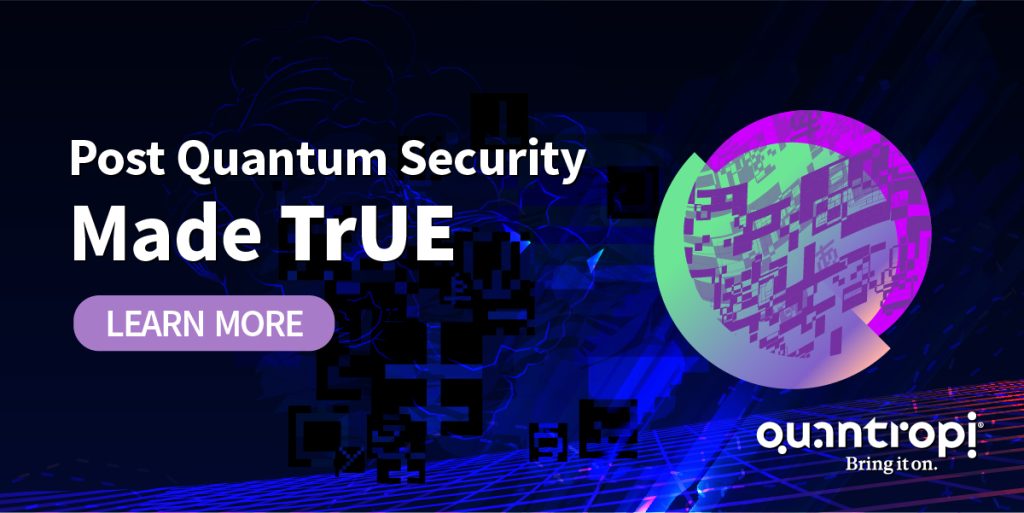In early 2020, there were 4.7 billion Internet users worldwide, a staggering 1,187% growth over just two decades. Furthermore, our increasing reliance on Internet-powered technologies generates massive amounts of data ( – that’s 1 followed by 21 zeros!)
Much of this data contains “sensitive” information that needs to be encrypted. We use specialized encryption systems to ensure that this data can only be accessed by authorized users in possession of encryption keys.
For decades, we’ve been using the same cryptographic systems, like RSA, to protect our data. These cryptographic systems were largely effective – but very soon, they’ll become powerless against the quantum threat. And the only way to prevent a global collapse of our IT infrastructure is to use cryptography that is resistant to quantum attacks.
But what differentiates classical cryptography from the newer quantum cryptography? How is quantum cryptography different from post-quantum cryptography? And how exactly can novel quantum-safe cryptosystems protect us?
Let’s explore the answers to these questions below!
Classical, Quantum, and Post-Quantum Cryptography: The Differences
The purpose of all three types of cryptography is to encrypt data and ensure its security, integrity, and authenticity. However, the three cryptography technologies drastically differ in how they protect data.
Here’s a quick summary of the differences between classical cryptography, post-quantum cryptography, and quantum cryptography:
- Classical cryptography uses difficult mathematical problems to protect data from non-quantum threats.
- Post-quantum cryptography also relies on mathematical problems, but they’re much more difficult than in classical cryptography and can withstand quantum attacks.
- Quantum cryptography exploits the properties of quantum mechanics, rather than difficult math problems, to protect data from quantum threats.
The differences don’t end here though. Let’s take a slightly deeper look into each cryptographic system to get a better idea of their differences.
Classical Cryptography
Classical cryptography encompasses the standard encryption algorithms that pretty much every business or government entity uses today to protect its data. Think systems like AES (Advanced Encryption Standard) or RSA (Rivest-Shamir-Adleman).
Classical cryptography is based on intractable mathematical “puzzles” that would take a classical computer thousands of years to solve. These “puzzles” can be built on math problems like large number factorization and discrete logarithms. Classical computers, no matter how powerful, cannot crack these problems and decrypt protected data in any reasonable time span. So unless hackers somehow get their hands on your encryption keys, your data should be safe.
In classical cryptography, the communicating parties share a secret sequence of random numbers called a “key.” In symmetric encryption, the communicating parties use the same key both to encrypt and decrypt data. In asymmetric (public-key) encryption, the sender uses the recipient’s public key (visible to anyone) to encrypt data, while the recipient uses their secret private key to decrypt data.
The security of classical cryptography depends on the secrecy of the key. If you keep your keys away from prying eyes, it’s practically impossible for your data to be compromised – at least, until powerful quantum computers arrive.
This neatly transitions us into the next cryptographic technology – post-quantum cryptography.
Post-quantum Cryptography
Post-quantum cryptography, or PQC, is an evolution of classical cryptography. Like classical cryptography, PQC is based on math problems. However, PQC extends classical cryptography’s property of intractability to quantum computers. To achieve this, PQC employs much more difficult math problems that are believed to be unsolvable even for quantum machines.
The fact that both classical and post-quantum systems rely on math problems leads to an interesting benefit – PQC solutions can be easily implemented in code and delivered to any device via software updates.
Post-quantum cryptography systems are mainly asymmetric (public-key), though there are symmetric systems in development as well. The reason why PQC systems tend to be asymmetric is that symmetric cryptography is believed to be resistant to quantum computers – at least, for the foreseeable future.
In asymmetric cryptography, the private key is mathematically related to the public key. This means that with enough computing power, hackers could derive the private key from the public key (which is visible to anyone). This is unachievable on classical computers but will become very easy with quantum machines.
Hackers could potentially use your public key as an entry point into your corporate network. Symmetric algorithms don’t have this weakness because they imply that the encryption/decryption key never goes public. And that’s why for now, most PQC algorithms are public-key or asymmetric.
Quantum Cryptography
Just like post-quantum cryptography, quantum cryptography’s aim is the protection of data from quantum threats. But the way it works is very different.
Quantum cryptography (sometimes called quantum encryption) is based on physics and relies on the properties of quantum mechanics for data security. Quantum cryptography harnesses the unpredictable nature of matter at the quantum level to encrypt and decrypt messages and guarantee the security of your communications.
Information in classical and post-quantum cryptography is encoded in bits, while quantum cryptography uses qubits. In this sense, quantum cryptography is just like quantum computers.
The best-known example of quantum computing cryptography today is quantum key distribution, or QKD. QKD makes it possible for two parties to share data in secure, unbreakable, eavesdropper-safe ways.
Unlike the other two methods, QKD can help the communicating parties detect eavesdropping attempts. Because of the properties of quantum mechanics – like the no-cloning theorem – hackers cannot directly measure data transmitted over a QKD connection. And if they tried, they would introduce errors to the qubits, immediately alerting the communicating parties that their connection isn’t secure.
Aside from that, quantum cryptography is theoretically resistant to increases in quantum computing power. No matter how strong the onslaught of quantum computers is on quantum cryptography, it’s believed that it won’t break. Computing power cannot bend the laws of physics, so quantum cryptography is protected by the laws of nature itself.
That being said, remember the stress on “theoretical” when considering the benefits of QKD. If implemented badly, QKD is much less secure than PQC. Setting up a QKD communication channel requires careful configuration and a proper set of hardware.
And speaking of hardware, QKD requires dedicated optical fiber connections and photon emitters to send and receive encrypted data. At enterprise scales, setting up an infrastructure for QKD can be a multi-million-dollar endeavor. You can’t just inject standard QKD into your infrastructure via software updates – specialized hardware channels are a prerequisite for QKD.
However, some quantum cybersecurity vendors are working on digital alternatives to QKD. These alternatives retain the beneficial properties of standard QKD while being much easier to deploy.
Post-Quantum Cryptography: Quantropi Leads The Way With QiSpace™
In the not-too-distant future, quantum computing algorithms will break many of the encryption protocols that today’s networks and information security depend on. This will endanger data and make organizations, governments, and individuals vulnerable to data theft and misuse. To prepare for this new era of quantum computing, many governments are primarily supporting the development of post-quantum cryptography because of its cost-effectiveness compared to quantum cryptography.
But while PQC is promising, most PQC algorithms have some serious disadvantages. We believe that to stay ahead of the fast-approaching quantum threat and to protect their communication networks, customers and users, organizations and governments need to deploy next-generation PQC solutions.
Quantropi’s asymmetric cryptographic solution, MASQ™, offers a proprietary, novel PQC algorithm that is much more efficient than NIST finalists. MASQ™ doesn’t require you to upgrade your infrastructure just to run PQC, and it also can operate on resource-constrained devices like smartphones or laptops.
MASQ™ is part of Quantropi’s flagship quantum-safe platform QiSpace™. To learn more, contact an authorized Quantropi representative today.
Much of this data contains ‘sensitive’ information that needs to be encrypted. Many encryption methods are used to ensure that this data can only be accessed by authorized users in possession of ‘encryption keys’.
But are these ‘traditional’ or ‘classical’ methods truly effective at keeping data encrypted and safe?
What differentiates Classical Cryptography (CC) from newer Quantum Cryptography (QC)?
And finally, do we need Post-Quantum Cryptography (PQC)? Why?
Classical and Quantum Cryptography: The Differences
In general, the purpose of both Classical Cryptography and Quantum Cryptography (also known as quantum security or quantum encryption) is to encrypt data, and ensure its security, integrity and authenticity. But there are several differences between the two approaches.
First, CC is based on intractable mathematical puzzles that are unsolvable on a classical computer for billions of years. These puzzles include large number factorization and discrete logarithms. It is their intractable nature that prevents unauthorized users from eavesdropping on encrypted messages in a CC-protected system. QC however, is based on Physics and relies on the properties of Quantum Mechanics for data security. Interestingly, PQC (covered in the next section), takes a similar approach as CC by extending the latter’s property of intractability to quantum computers. In other words, it builds on Math puzzles believed to be intractable even by quantum computers to provide secure communications.
In CC, the communicating parties share a secret sequence of random numbers or a ‘key’. So the security of the method depends on the secrecy of the key, leaving it vulnerable to security loopholes. QC harnesses the unpredictable nature of matter at the quantum level (‘qubits’) to encrypt and decrypt messages, and guarantee more secure communication.
Two commonly-used methods for Advanced CC are Data Encryption Standard (AES) and Public Key Cryptography (PKC). In the former, the key consists of a randomly-chosen, long string of bits which determines the security of the communication channel. With the latter approach, each user has two keys: public and private, each of which does only half of the encryption/decryption process. The numbers created by the combination of the key and the encoding can reach staggering proportions, adding to the system’s complexity and cost. Moreover, with exponential increases in computing power and the encroaching approach of quantum computing, these numerical keys are no longer able to provide truly secure communication. Unlike CC methods, QC provides ways for users to securely establish secret keys and detect eavesdropping if it occurs. Therefore, it can protect data in ways that current encryption methods – some of which have been around for over two decades – can’t.
The best-known example of QC today, Quantum Key Distribution (QKD) makes it possible for parties to share data in secure, unbreakable, eavesdropper-safe ways.
Post-Quantum Cryptography: Quantropi Leads The Way With QEEP™
In the not-too-distant future, QC algorithms will likely break many of the encryption protocols that today’s networks and information security depends on. This will endanger data and make organisations, governments and individuals vulnerable to data theft and misuse. To prepare for this new era of quantum computing, many governments are promoting the development of Post-Quantum Cryptography (PQC).
But the UK’s National Cyber Security Centre (NCSC) has expressed scepticism about the promised benefits of these technologies, including maths-based PQC algorithms, physics-based Quantum Random Number Generation (QRNG) and even QKD. At Quantropi, we think this scepticism is warranted. We believe that to stay ahead of the fast-approaching QC curve, and to protect their communication networks, customers and users, organisations and governments need to deploy next-generation PQC solutions.
Quantropi’s unique Quantum Entropy Expansion and Propagation (QEEP™) is a secure application of the logical implementation of n-qubit quantum permutation gates. QEEP™ offers quantum-secure random key exchange, making information uninterpretable over unlimited distances. Plus, it works with existing infrastructure and offers scalable security to accommodate growing network bandwidth demands.
Protect your organisation and ensure quantum-safe communication with QEEP™. To know more, contact an authorized Quantropi representative today.


